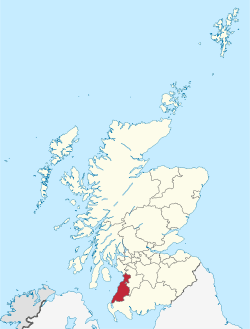Dunure
Dunure (Scottish Gaelic: Dùn Iùbhair, meaning Yew Hill) is a small village in the South Ayrshire area of Scotland. Located on the coast of the Firth of Clyde, Dunure is near to Maybole. The Dunure Labyrinth in the Kennedy Park, The Labyrinth was created by Andy and his wife Helen, Andy Guthrie is on the Community Council, well known Helen and Andy are pagans and run the Dunure environmental group, the Labyrinth is popular with folks from all around the world, Dunure Labyrinth has a Facebook page.
The villages
The first buildings in the lower Dunure village were erected in the early nineteenth century, not long after improvements to the local harbour in 1811. Kennedy Hall dates from 1881 and Dunure House from around 1800. Limekilns are a common feature of small harbours and Dunure has a fine specimen at the village play park.[1]
Fisherton Church was erected in 1938 as a chapel of ease for Dunure and district. It was rebuilt and extended in 1912. Dunduff Castle stands above Fisherton; originally a 15th-century structure it was altered and extended in the 1980s for use as a private house. The remains of a prehistoric earthwork, the Dane's Hill, are located in a nearby field. The ruins of the pre-reformation Kirkbride church and cemetery are nearby, abandoned since the parish was combined with that of Maybole.[2]
Harbour
The harbour is a roughly square basin with a breakwater quay, topped off by a characteristic cylindrical stone harbour light. The Earl of Cassillis improved the harbour at a cost of £50,000 in 1811, making the location more attractive for fishing. The depth of the water in the harbour is 12 feet (3.7 m) at ordinary spring tides, but could be artificially increased to almost 30 feet (9.1 m).[3] William Aiton records in 1808 that the sole costs of the improvements to Dunure harbour were borne by Thomas Kennedy of Dunure Esq.[4]
Transport
There was previously a Dunure railway station in the village on the Maidens and Dunure Railway, however this station closed in the 1930s.
Items of local interest
John Keppie was a colleague of Charles Rennie Mackintosh who rented the house of Mainslea and a small cottage in its back garden, opposite Dunure Castle for “The Roaring Camp”; a holiday home for girl friends of theirs from the Glasgow School of Art. It was from this base that Mackintosh set out on a sketching expedition to the abbey of Crossraguel, Baltersan and Maybole in 1895.[5]
The famous Electric Brae and the substantial ruins of the infamous Dunure Castle are located near the village. Dunduff Castle above Fisherton primary school has been rebuilt and is now a private home; the old parish cemetery and pre-reformation church ruins lie near Dunduff Farm. The mounted skeleton of the famous Clydesdale horse 'Baron of Buchlyvie' is a popular attraction for the Kelvingrone Museum and Art Galleries in Glasgow. The Baron finished his days at Dunure Mains Farm and was originally buried there.[6]
A labyrinth has been constructed in a hollow on the headland overlooking by the castle, in May 2008 Andy Guthrie was awarded £3,990 from Awards for All to construct the Dunure Labyrinth with the help of the village and B.T.C.V all so C.S.V and the Dunure Community Council and Fisherton primary school it was a great success Action Earth award them a biodiversity certificate all so the biodiversity Award from S.N.H Scotland, Jeff Saward advise on the history of labyrinths, now a part of the community the Labyrinth has had visitors from all round the world, and has its own Facebook page Dunure Labyrinth. It looked after by volunteers from the village and pagan groups from around Scotland, open all year.
References
- ↑ Love, Dane (2003). Ayrshire : Discovering a County. Ayr : Fort Publishing. ISBN 0-9544461-1-9. p. 298.
- ↑ Love, Dane (2003). Ayrshire : Discovering a County. Ayr : Fort Publishing. ISBN 0-9544461-1-9. p. 297 - 298.
- ↑ Harvey, William. Picturesque Ayrshire. Dundee : Valentine and Sons. p. 30.
- ↑ Aiton, William (1811). General View of The Agriculture of the County of Ayr; observations on the means of its improvement; drawn up for the consideration of the Board of Agriculture, and Internal Improvements, with Beautiful Engravings. Glasgow. Page 55.
- ↑ Brown, James (2007). Cherchez l’’origine! How Ayrshire inspired Scotland’s greatest architect/designer and how Ayrshire can now benefit.
- ↑ Love, Dane (2003). Ayrshire : Discovering a County. Ayr : Fort Publishing. ISBN 0-9544461-1-9. p. 299 - 300.
Coordinates: 55°24′N 4°45′W / 55.400°N 4.750°W
External links
| Wikimedia Commons has media related to Dunure. |
- Dunure Community Council Dunure Community Council Web Site
- Pictures of Dunure
- Pictures of Dunduff Castle
Dunure Labyrinth Facebook page

